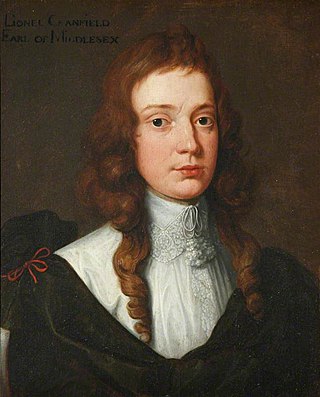Related Research Articles

Dorothy Sidney, Countess of Leicester, was the eldest daughter of Henry Percy, 9th Earl of Northumberland, and his wife, Lady Dorothy Devereux. Her sister was the alleged intrigant Lucy Hay, Countess of Carlisle, and their eldest surviving brother was Algernon Percy, 10th Earl of Northumberland.

Mary Scudamore was a courtier to Elizabeth I.

Lionel Cranfield, 3rd Earl of Middlesex was an English peer, styled Hon. Lionel Cranfield from 1640 until 1651.
Joan Vaux, Lady Guildford, also known as Mother Guildford, was an English courtier who was the Lady Governess to the Princesses Margaret Tudor and Mary Tudor. She accompanied Mary Tudor to France when she married King Louis XII in 1514.
Margaret Bourchier, Countess of Bath was an English Tudor noblewoman. She is notable for the three high-profile and advantageous marriages she secured during her lifetime, and for her success in arranging socially impressive marriages for many of her children. Through her descendants she is a common ancestor of many of the noble families of England.
Anne, Lady Waller was an English diarist and patron of clergy.
Anne Venn was an English religious radical and diarist. Her diaries document her worry that she was damned. She found some relief in 1652 and she gave substantial legacies to the church in Fulham.
Mary Cary Rand was an English writer, prophetess and pamphleteer supporting the Fifth Monarchists during the English Civil War.
Lady Elizabeth Fane born Elizabeth Brydges was an English writer and literary patron.
Ann Carter was an English activist from Maldon, Essex, who was executed for her leading part in the Maldon grain riots of 1629. She used the title "captain", and was hanged on 30 May 1629.
Winefred Wigmore (1585-1657) was an English Roman Catholic nun and teacher, a friend and biographer of Mary Ward.
Katherine Doyley Dyer notable for the epitaph she placed on her husband's tomb at Colmworth, Bedfordshire, England

Nazareth or Nazaret Newton was a courtier and lady-in-waiting.

Susanna Temple, Lady Lister was an English courtier.
Margaret Ratcliffe or Radcliffe or Radclyffe (1575-1599) was an English courtier.
Lucy Cary was an English Benedictine nun and biographer.

Aura Soltana, also known as Ipolitan the Tartarian or Ipolita or Ippolyta, was a Tartar woman at the court of Elizabeth I after arriving from Russia to England, apparently as a slave.
Alexander Unton was an English landowner.
Mary Lakeland also known as Mother Lakeland and the “Ipswich Witch”, was an English woman executed for witchcraft in Ipswich. She belonged to the few people in England to have been executed by burning after a conviction of witchcraft. She was the last person executed for witchcraft in the town of Ipswich.
Elizabeth Lowys, was an English woman executed for witchcraft. She is known as the first woman to be executed for witchcraft in England after the passing of the Witchcraft Act 1563.
References
- ↑ Carole Levin, Anna Riehl Bertolet, Jo Eldridge Carney, A Biographical Encyclopedia of Early Modern Englishwomen
- 1 2 'Long Meg of Westminster': a mystery solved." Notes and Queries, vol. 45, no. 3, Sept. 1998, pp. 302+.
- Carole Levin, Anna Riehl Bertolet, Jo Eldridge Carney, A Biographical Encyclopedia of Early Modern Englishwomen